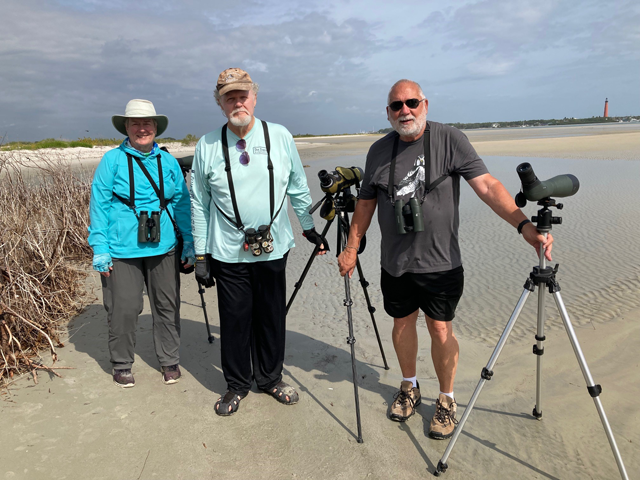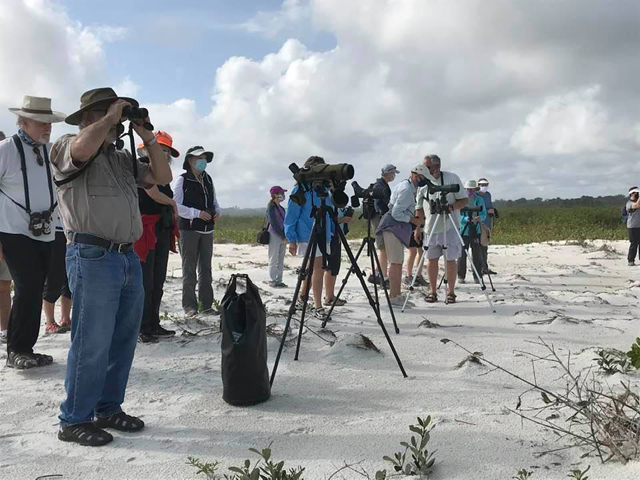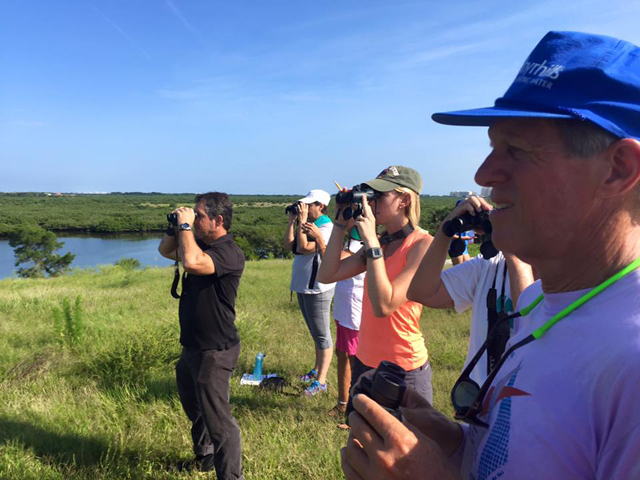The Marine Discovery Center launched its Winter Birding Tours in 2019 as an answer to a request from local Audubon chapter members. Local birders wanted a way to view shorebirds and migratory birds en route to their Arctic nesting grounds during the winter months, but found this was only possible by boat in some places.
MDC had the boat, a staff naturalist who was an Audubon chapter member and the tours were born! Now, each winter, MDC’s Discovery boat transports birders once a month — January through April — to Disappearing Island in Ponce Inlet where guests and guides disembark and walk out to view resident and migratory avian species.
Teaming up with MDC staff to lead up to 40 passengers per tour are Don Chalfant of Southeast Volusia Audubon, and David Hartgrove and Joan Tague of Halifax River Audubon. Guests and guides spread out to view birds with at least four spotting scopes and a host of binoculars used during each tour.
Chalfant has led walking birding tours at MDC and Indian River Lagoon Preserve Park for around 15 years. Tague has been a field trip leader and guest speaker for Halifax River Audubon and has taught local birding classes. Hartgrove has served as president and conservation chairman of Halifax River Audubon and has taught basic birding observation to hundreds of Volusia County high school students through the school system’s IBIS program at Rose Bay.
Read what Don, David and Joan have to say about Audubon’s role in MDC’s Winter Birding Tours in this interview with MDC Winter Birding Tour naturalist and staff writer Lisa D. Mickey:
Q: Why are Winter Birding trips like this important?
David: One of the main reasons is that people who don’t have much experience at all with birds get a chance to spend time in the field with people who know a lot about them. The fact that we can share interesting stories about the birds that we see helps to engender enthusiasm in those folks to think about maybe buying a pair of binoculars or a field guide to learn more. That also leads to more people concerned about conservation.
Don: On these field trips, specifically, it’s an opportunity for beginning and experienced birders to have a chance to go to a local spot that’s hard to reach unless you have your own boat. Disappearing Island is a real hot spot in this area. These tours offer a unique opportunity to see the migratory birds there.
Joan: It’s an opportunity to get out into an environment that a lot of people don’t get to explore. I’m really taken by people from other parts of the United States who find this tour and are absolutely thrilled by it. Other tour opportunities really don’t take you to this kind of a place. It’s truly unique.
Q: What do Audubon chapters bring to our communities?
Joan: First of all, Audubon chapters are committed to conservation – to conserving the land around us, for providing habitat and perpetuating good environment for birds, for fellowship, for education and an opportunity for people to come together and educate each other about the surrounding ecosystem. The focus is always on birds. You can go to other groups and the focus is on plants, butterflies, turtles or whatever. With Audubon, it’s the birds and the window that we use to look at the environment around us. We have an appreciation for everything, including the lagoon, different waterways, plants, and how everything all fits together.
Don: When I first joined an Audubon chapter, it was just a way for us to find birds, but it has become so much more than that. I describe birders as those who find the spiritual, physical and more recently, the social endeavor of appreciating a species. I’ve met people who share the same values and they really do value conservation and a commitment to improving a habitat for these birds.
David: Obviously, being Audubon, we talk a lot about birds, but we also talk about other things, such as sea grass. We now know that because of the disappearing sea grass, we have manatees that are starving to death. All of these things are a part of an interconnected web of life. If we can get more sea grass growing so that manatees survive, that sea grass also provides a substrate for all kinds of little animals that filter the water, which then makes for a cleaner Indian River Lagoon. That also means birds do better, the mammals do better and the human beings do better because the fish that we are eating out of the lagoon are not contaminated. All of these things are important to members of Audubon. Other groups, such as the Florida Native Plant Society and the Sierra Club, also work together to foster a better environment for all of us.
Q: Are local Audubon chapters just for experienced birders?
David: Oh no, not at all! It’s one of the best ways I know to get your feet wet and to go out on field trips with experienced birders. It just opens up the world to all levels to keep learning new things.
Don: It’s just the opposite. When I lead trips, I find that people who come on my bird walks are interested in plants and animals, as well. You can’t separate just one thing. They are all inter-related. As a result of my interest in birds, I’ve also become interested in wild flowers, butterflies and dragon flies.
Joan: A lot of us travel to view birds because you only see certain birds in certain places. To build a list of birds seen or to experience different species, you have to get out on the road a bit. Audubon makes a great resource when you travel to different sites. You can contact people at local Audubon chapters or ask what species are there locally. You can sometimes join their outings and see new birds or learn new things. I might be an experienced birder in Florida, but if I go to Arizona, I’m not an experienced birder there. That environment is all new to me. You really need guides to help and local Audubon chapters can provide that. It’s a more of a resource for people interested in birds at all levels.
Q: How has the Marine Discovery Center helped local Audubon chapters with their public outreach objectives?
Joan: MDC gives us opportunities to tell our story and the boat trip allows us to visit a unique birding destination.
Don: Not only has the Marine Discovery Center sponsored the bird walks for the last 15 years, but it has worked in conjunction with the Southeast Volusia Audubon chapter in the development of a butterfly/bird wildflower garden. Recently, we put up bird housing on the MDC campus with the hope of developing a purple martin colony there. And the restoration of the salt marsh behind the center to create a new wetland has attracted some additional birds over the last nearly 10 years. When I lead bird walks on the MDC grounds, I show guests a photo of how it looked before the wetland was reestablished and they’re just amazed to see it now. The benchmark bird that is proof the marsh restoration was a successful project has been the clapper rail, which we either see or hear on every trip. The Marine Discovery Center is also a host instructional site for the Florida Master Naturalist Program and provides a meeting place for Southeast Volusia Audubon. There is no question that MDC and Audubon are hand in hand.
Q: Why should citizens care about birds?
David: To borrow the analogy, birds are the canary in the coal mine. Coal miners used to carry little caged birds into the mines because birds were much more sensitive to the presence of dangerous gases than humans. They were there to provide an early warning to the miners. In this case, birds are our early warning of the types of threats that we see in our environment. When pesticide use goes up, we see declines in bird populations. Those chemicals are long-lasting and we saw that with the use of DDT after World War II. In 1960, there were maybe 400 pairs of bald eagles left in the United States because of DDT. Once DDT was banned in 1972, the populations of eagles and other birds at the top of the aquatic food chain immediately went up.
Joan: Birds are pretty and charismatic. Look at music, poetry, art and aerospace. I’m sure people looked at birds and asked, “Why can’t I fly?” Back in our roots as humans, birds were always mysterious, fascinating and awe-inspiring. It’s an animal that will look you in the eye. I’ve been out when it was just me and a bird face to face, with nobody else around, and the animal recognizes you as something. When something in nature looks at you and recognizes you, it just makes you feel closer to nature.
Q: Once you become a birder, it seems you never stop learning.
Joan: Absolutely! There’s always something to learn. I remember once sitting on a restaurant balcony overlooking the city of Pittsburgh, where I used to live. We would watch red-tailed hawks riding the thermals and all of a sudden, they would just dive straight down. I have mental snapshots of birds all through my life that have just taken my breath away.
David: If you’re into birds, there’s always a new field guide to buy or another book you want to add to your bird library. There are so many interesting things to learn about them. Birds are just fascinating creatures. They make us wish we could fly like they do. Just watch a brown pelican skimming over the water at the beach. They are poetry in motion, gliding with such ease.
Don: There’s always something new to see and to learn and I truly appreciate these Winter Birding Tours offered by the center. Some birders truly need this particular outlet to learn, so thank you MDC for giving us the ability to help so many people become interested in birds.
Want to book a spot on our next Winter Birding Tour? These 3-hour tours are held monthly January through April. Call 386.428.4828 or Book online now!





Follow Us!